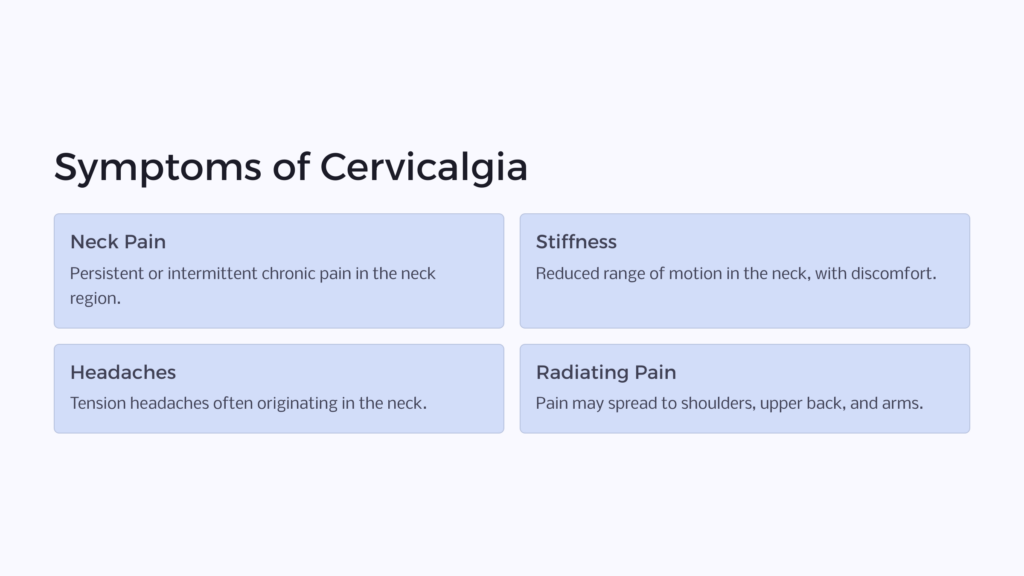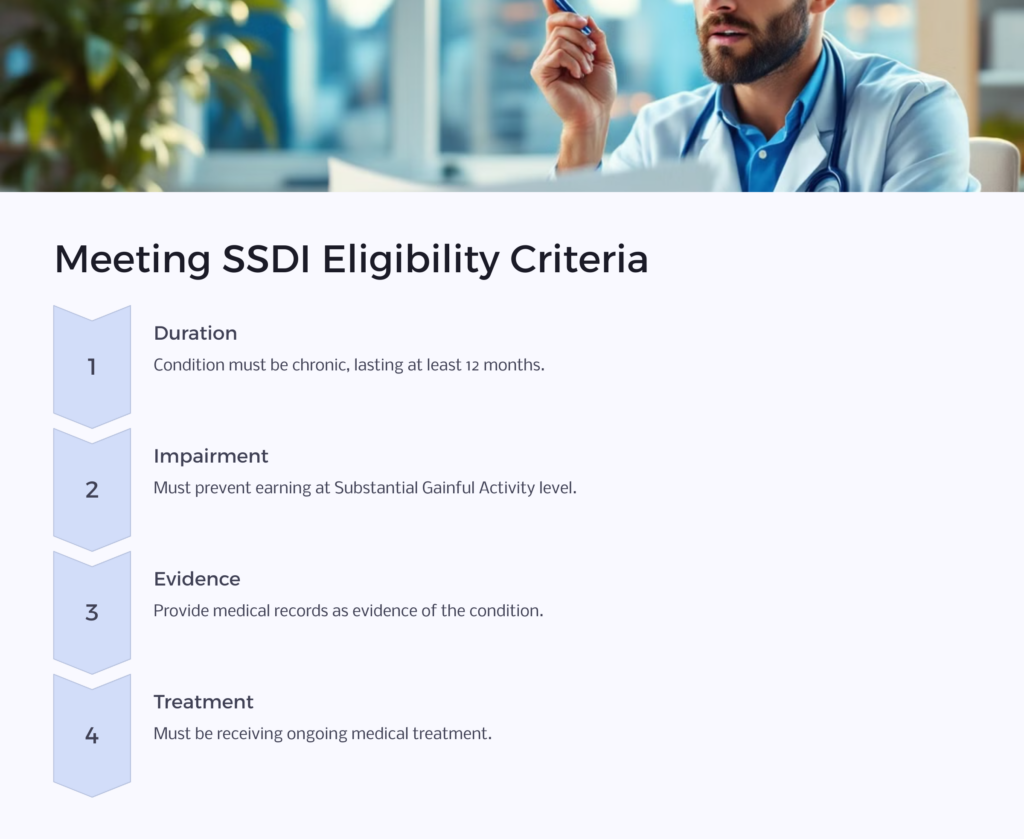Cervicalgia is a condition that affects the neck, and the pain it causes can be persistent. Many struggle with this condition, and its impact extends beyond health; it also raises financial concerns. Veterans Affairs can help you find the support you need. Let’s talk about qualifying for SSDI and the potential VA disability benefits available. We’re here to help walk you through the process so you succeed.
What Is Cervicalgia?

Cervicalgia refers to chronic neck pain that can vary in intensity and duration. It may occur suddenly through a neck injury or develop over time as a disease. The chronic neck pain associated with cervicalgia might even travel to other areas, such as the shoulders, upper back, and arms. Cervicalgia often points to issues in the cervical spine, which comprises the neck’s vertebrae, discs, and supporting structures. This leads to painful motion and eventual functional loss. It is important to know that this condition can often develop injury and strain to the neck and spinal cord due to military service; thus, veterans are at high risk for this condition.
Symptoms of Cervicalgia

Common symptoms of this neck condition include:
Neck Pain: Persistent or intermittent chronic pain in the neck region.
Stiffness: Reduced range of motion in the neck, accompanied by stiffness and discomfort.
Headaches: Tension headaches, which often originate in the neck.
Radiating Pain: Chronic pain may radiate from the neck down into the shoulders, upper back, and arms.
Muscle Tension: Tightness caused by muscle spasm in the neck and upper back.
Prognosis and Impact on Functionality
The prognosis for individuals with cervicalgia can vary. Some may experience temporary discomfort that responds well to treatment with a physical therapist. Others may face shoulder pain, painful motion in the neck, and other problems around that area. The impact of cervicalgia on functionality depends on the severity of symptoms. A severe muscle spasm can cause functional loss, hindering your ability to work and live as you should be able to. Because of the severity of this condition, the VA may rate it as a total disability.
Who Does Cervicalgia Affect?
Cervicalgia can affect individuals of all ages, but some groups are more commonly affected. Those at higher risk include:
Office Workers: Individuals who spend prolonged periods sitting at a desk, working on a computer, or performing repetitive tasks that strain the neck.
Senior Citizens: As we age, the risk of cervical spine degeneration increases, leading to a higher prevalence of cervicalgia among older adults.
Trauma Survivors: Individuals who have experienced injuries or trauma to the spinal cord or spinal canal, such as whiplash from car accidents or sports-related injuries. We include veterans with military service as a large part of this group.
Underlying Medical Conditions: People with conditions like osteoarthritis, herniated discs, or spinal stenosis may be more susceptible to cervicalgia.
Postural Issues: Poor posture, especially while using electronic devices, can contribute to the development of cervicalgia.
Meeting SSDI Eligibility Criteria

Qualification for VA disability benefits depends on the severity and duration of the medical condition. To qualify for SSDI due to cervicalgia, you must meet the following criteria:
Duration of the Condition: Your cervicalgia must be chronic (expected to last at least 12 months).
Substantial Impairment: The condition must prevent you from earning the income level associated with SGA (Substantial Gainful Activity).
Medical Evidence: You must provide any medical record serving as evidence of your condition.
Continuity of Treatment: You must already be receiving medical treatment for your neck condition.
The Role of Medical Evidence
To strengthen your VA disability claim for cervicalgia, thorough medical documentation is crucial and you can receive them through a physical examination that proves your case. This documentation should encompass:
Diagnostic Records: Records of your cervicalgia diagnosis, including imaging studies like X-rays or MRI scans, and reports from specialists.
Treatment History: A detailed history of your medical treatments, including medications, physical therapy, and surgical interventions related to cervicalgia.
Functional Limitations: Documentation of how cervicalgia impairs your ability to work and perform daily activities. This may include statements from your healthcare provider, physical therapist, or occupational therapist.
Types of Benefits for Cervicalgia

Social Security Disability Insurance (SSDI)
SSDI provides financial assistance from the federal government to disabled individuals. To be eligible for SSDI, you must have earned enough work credits by paying Social Security taxes over the years. The exact number of required credits depends on your age at the time of disability onset.
SSDI will base amounts of financial aid on your average lifetime earnings before your disability. These payments are there to help during times of financial instability.
Supplemental Security Income (SSI)
To qualify for SSI, your income and resources must be below certain limits set by the SSA.
SSI benefits cover basic living expenses, including food, shelter, and clothing. Payment amounts may vary depending on your income and living arrangements.
Navigating the SSDI Application Journey
SSDI application can be time-intensive, but with the right preparation, you’re set up for success. Here’s everything you need to cover:
Step 1: Assess Your Eligibility
Before beginning your application, try to be sure that you meet the eligibility criteria. This includes having a qualifying long-term disability, accumulating sufficient work credits, and meeting the Substantial Gainful Activity (SGA) requirements.
Step 2: Assemble Your Medical Documentation
Collect any relevant medical record such as a physical examination, test results, statements from your healthcare provider, and any other documentation that bolsters your VA disability claim. The more extensive your medical evidence, the stronger your case becomes.
Step 3: Complete the Application
You can start your SSDI application online via the Social Security Administration’s website or by visiting a local SSA office. The forms will include information about your cervicalgia, employment history, and medical treatment.
Step 4: Submit Your Application
After completing your application, submit it to the SSA, and be sure to maintain copies of all documents for your records.
Step 5: Await a Determination
Following the submission of your application, the SSA will scrutinize your case to establish your eligibility. This phase can take several months, so practice patience.
Step 6: Pursue an Appeal if Necessary
In the event that your initial application faces rejection, don’t give up! Many SSDI applicants encounter initial denials. You have the right to appeal this decision. Consult with an attorney or advocate who specializes in disability cases to navigate you through the appeals process.
Seeking Legal Assistance and Managing Appeals
Due to the nature of the VA disability rating system—the difficulty of judging cases individually—it’s possible they may deny your claim. This is where bringing in a legal professional can save your case. Consider the following key points:
- Engage an Attorney: Don’t be afraid to use this resource! Disability lawyers are there to guide you and advocate for you.
- Appeals Process: In the case of rejection, remember that you can still appeal.
- Medical Evidence: Continue to gather and submit medical documentation to strengthen your case.
- Exercise Patience and Perseverance: The appeals process often takes a while. Be prepared to wait, but don’t give up on the VA benefits you deserve.
We’re Here to Help
Cervicalgia can be debilitating. The VA disability rating system can determine what help you need, and social security systems can be a safety net for you. Finding yourself eligible for benefits can relieve financial, physical, and emotional burdens. Stay in the know with Benefits.com. We want you to access the help you need to live your very best life!
 Benefits.com Advisors
Benefits.com Advisors
With expertise spanning local, state, and federal benefit programs, our team is dedicated to guiding individuals towards the perfect program tailored to their unique circumstances.
Rise to the top with Peak Benefits!
Join our Peak Benefits Newsletter for the latest news, resources, and offers on all things government benefits.


















